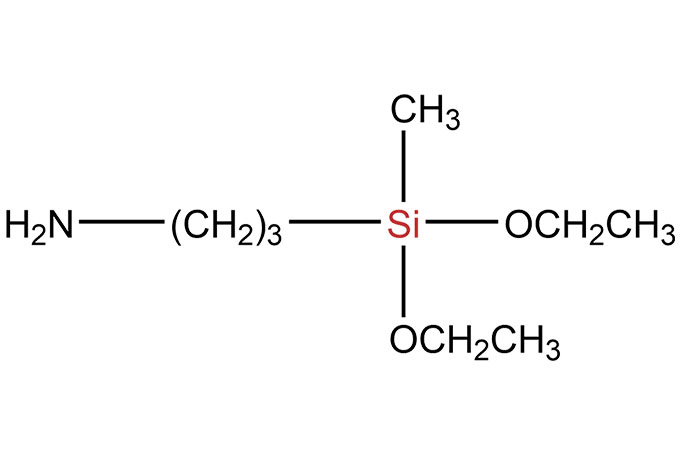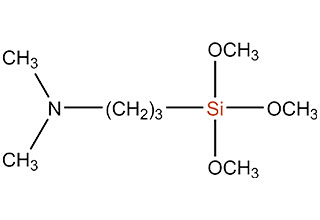Technical Data
CAS No. | 3179-76-8 |
EINECS No. | 221-660-8 |
Formula | C8H21NO2Si |
Molecular Weight | 191.3 |
Boiling Point | 88°C [15mmHg] |
Flash Point | 68°C |
|
|
Color and Appearance | Colorless transparent liquid |
Density 25/25°C | 0.916 |
Refractive Index | 1.4272 [20°C] |
Min. Purity | 98.0% |
Reactivity:
SiSiB® PC1120 is a bifunctional organic compound in which the silicon-functional OC2H5 -groups hydrolyze in the presence of water to give ethanol and the corresponding reactive silanols, which can be bonded to an inorganic substrate; the organophilic amino group can interact with a suitable polymer.
The hydrolysis of SiSiB® PC1120 takes place autocatalytically in a short time of about 5-10 minutes. Hydrolysates having a concentration of < 5% are stable for more than 72 hours. The pH is about 11.
Examples of suitable inorganic substrates are glass, glass fibres, glass wool, mineral wool, silicic acid, quartz, sand, cristobalite, wollastonite and mica; also suitable are aluminium hydroxide, kaolin, talc, other silicate fillers, metal oxides and metals.
Examples of suitable polymers are epoxy resins, polyurethanes, phenolic resins, furane resins, melamine resins, PA, PBT, PC, PEK, PE, EVA, PP, PVB, PVAC, PVC, acrylates and silicone.
SiSiB® PC1120 can undergo reactions with ketones or esters as solvents. Silane or silanized substrates can react with carbon dioxide to form the corresponding carbonates resp. carbamates. Product modifications are possible through addition reactions with suitable monomeric or polymeric compounds (for example isocyanates, epoxides, etc.) or by co-condensation with polysiloxanes.
Application
SiSiB® PC1120 silane coupling agent is an important or even essential constituent in many applications. SiSiB® PC1120 is particularly important as an additive to cold-curing phenolic and furan foundry resins to improve the flexural strength of sand/resin elements with very long shelf life of the resins.
Further examples are:
Glass fiber/glass fabric composites: as size constituent or finish
Glass and metal primers
Abrasives: as additive to phenolic resin binders
Sealants and adhesives: as primer or silicone additive and for chemical modification
Mineral-filled composites: for pretreatment of fillers and pigments or as additive
Synthesis of functional silicones
The most important effects which can be achieved using PC1120 are improvements in product properties, such as
Adhesion
Mechanical properties, for example flexural strength, tensile strength, impact strength and modulus of elasticity
Moisture and corrosion resistance
Electrical properties, for example dielectric constant, volume resistivity
And improvements in processing properties, such as
Better filler dispersion
Rheological behavior: reduction in viscosity, Newtonian behaviour
Higher degree of filling
 English
English 日本語
日本語 한국어
한국어 français
français Deutsch
Deutsch Español
Español italiano
italiano русский
русский português
português العربية
العربية tiếng việt
tiếng việt
 SiSiB® PC1120 Technical Data Sheet
SiSiB® PC1120 Technical Data Sheet 

